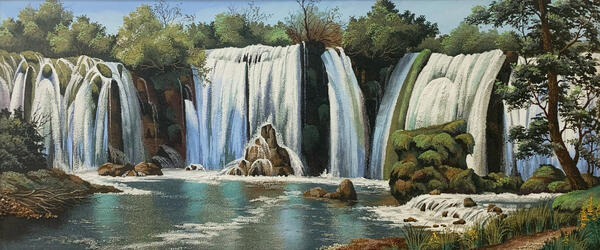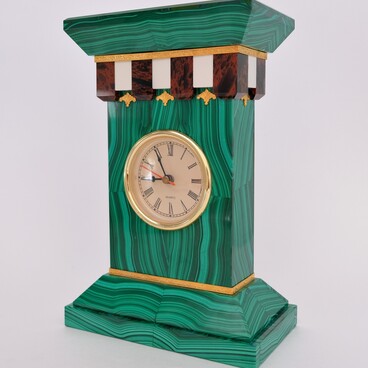In 1999, a group of Chelyabinsk masters created this decorative wall panel “Waterfalls” in the bulk painting technique. The image is made of different kinds of stone chips, with which the marble base was filled.
Stone chips are obtained from small fragments that are left after processing natural stones and are not suitable for other products. They are crushed in different ways: it is possible to process the mineral into fine dust, or to make larger fragments. In stone crumb painting, chips of different diameters can better convey not only the color scheme, but also the texture of the depicted objects.
Artists who work in this technique do not create preparatory sketches, as the sketch will be hidden under the first layer of material in the process of pouring stone crumbs and will not help the master. That is why the only element of the future work that can be determined beforehand is the general color palette: the master prepares all the necessary materials and, while working with the item, selects only the ones that will best show the desired color.
There are two different ways of creating an artwork using stone crumb. The first one implies that the base is coated with glue and the first layer of stone chips, the smallest ones, is applied. When it dries, larger chips are placed on top, they are the size of table salt. This alternation of sizes helps to create the effect of depth in the image. In addition, the master must work extremely carefully, but quickly, as when the glue on the base dries, the image cannot be altered.
The other method is to pour dry stone powder without glue onto the base and then cover it with varnish which will serve as an adhesive. Artists sometimes combine both methods in one work.
Stone chips for bulk paintings are usually a mixture of several minerals. Only marble is used in its pure form; however; sometimes crushed quartz is added so that the material becomes shinier. Astrophyllite is not used entirely: only impurities in the form of arrows and stars can be taken from it for an artwork. White marl is often chosen for winter landscapes, while malachite, aquamarine, and turquoise — for a spring one.
The panel “Waterfalls” was transferred to the museum from the regional administration of the Ministry of Culture of the Russian Federation for the preservation of cultural values in the city of Yekaterinburg.
Stone chips are obtained from small fragments that are left after processing natural stones and are not suitable for other products. They are crushed in different ways: it is possible to process the mineral into fine dust, or to make larger fragments. In stone crumb painting, chips of different diameters can better convey not only the color scheme, but also the texture of the depicted objects.
Artists who work in this technique do not create preparatory sketches, as the sketch will be hidden under the first layer of material in the process of pouring stone crumbs and will not help the master. That is why the only element of the future work that can be determined beforehand is the general color palette: the master prepares all the necessary materials and, while working with the item, selects only the ones that will best show the desired color.
There are two different ways of creating an artwork using stone crumb. The first one implies that the base is coated with glue and the first layer of stone chips, the smallest ones, is applied. When it dries, larger chips are placed on top, they are the size of table salt. This alternation of sizes helps to create the effect of depth in the image. In addition, the master must work extremely carefully, but quickly, as when the glue on the base dries, the image cannot be altered.
The other method is to pour dry stone powder without glue onto the base and then cover it with varnish which will serve as an adhesive. Artists sometimes combine both methods in one work.
Stone chips for bulk paintings are usually a mixture of several minerals. Only marble is used in its pure form; however; sometimes crushed quartz is added so that the material becomes shinier. Astrophyllite is not used entirely: only impurities in the form of arrows and stars can be taken from it for an artwork. White marl is often chosen for winter landscapes, while malachite, aquamarine, and turquoise — for a spring one.
The panel “Waterfalls” was transferred to the museum from the regional administration of the Ministry of Culture of the Russian Federation for the preservation of cultural values in the city of Yekaterinburg.



